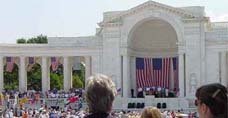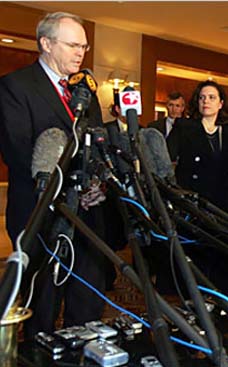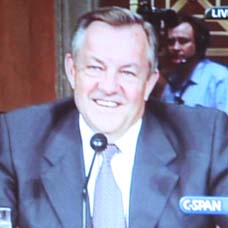2007.03.23: March 23, 2007: Headlines: National Service: National Service Academy: Congress: Washington Post: Stephen Barr writes: A Push to Create a Fresh Class of Public Servants
Peace Corps Online:
Peace Corps News:
Library:
Peace Corps: National Service Academy:
Peace Corps: National Service Academy: Newest Stories:
2007.03.23: March 23, 2007: Headlines: National Service: National Service Academy: Congress: Washington Post: Stephen Barr writes: A Push to Create a Fresh Class of Public Servants
Stephen Barr writes: A Push to Create a Fresh Class of Public Servants

Sens. Hillary Rodham Clinton (D-N.Y.) and Arlen Specter (R-Pa.) and Reps. James P. Moran Jr. (D-Va.) and Christopher Shays (R-Conn.) re-introduced legislation to create a U.S. Public Service Academy. A version introduced last September was too late for any congressional action, but Clinton and Shays promised to try to get the votes for passage this year. Chris Myers Asch and Shawn Raymond, who served in AmeriCorps together in Mississippi, came up with the idea for the academy after seeing friends shy away from government careers because of school debts or because they could not see themselves working in a large bureaucracy. "We are not getting people to come into public service," Moran said, in part because the cost of higher education steers young people to more lucrative jobs in the private sector. Moran said the academy is urgently needed because it would help fill staffing gaps in agencies created over the next decade as more federal employees retire.
Stephen Barr writes: A Push to Create a Fresh Class of Public Servants
A Push to Create a Fresh Class of Public Servants
By Stephen Barr
Friday, March 23, 2007; Page D04
It's a project without big-time lobbyists and with very little money. But advocates for a federally financed public-service academy have managed to put together a bill and line up congressional sponsors, and now hope to find committee chairmen to sponsor Capitol Hill hearings.
"A year ago, this was a piece of paper and a Web site," said Chris Myers Asch, who is a leader of the effort. "It has gotten a lot further and a lot faster than we anticipated. Folks from across the political spectrum have endorsed the idea."
Yesterday, Sens. Hillary Rodham Clinton (D-N.Y.) and Arlen Specter (R-Pa.) and Reps. James P. Moran Jr. (D-Va.) and Christopher Shays (R-Conn.) re-introduced legislation to create a U.S. Public Service Academy. A version introduced last September was too late for any congressional action, but Clinton and Shays promised to try to get the votes for passage this year.
The school would offer a free education to about 5,000 undergraduates in exchange for their commitment to work for five years in public-service jobs in local, state and federal governments.
The nation has supported "wonderful military academies," Clinton said, but "we don't have a comparable institution to prepare leaders on the civilian side."
Added Specter, "We need more professionalism in government."
Asch and Shawn Raymond, who served in AmeriCorps together in Mississippi, came up with the idea for the academy after seeing friends shy away from government careers because of school debts or because they could not see themselves working in a large bureaucracy.
"We are not getting people to come into public service," Moran said, in part because the cost of higher education steers young people to more lucrative jobs in the private sector.
Moran said the academy is urgently needed because it would help fill staffing gaps in agencies created over the next decade as more federal employees retire.
The bill sponsoring the academy does not say where it should be located, but proponents think Washington makes sense because the federal government serves as a magnet for public-policy scholars and is home to think tanks, nonprofit groups and federal agencies with specialists who could teach.
The proposed academy would use West Point and other military academies as models and would be administered by the Department of Homeland Security. A major goal of the academy would be to train leaders in education, health care and law enforcement to bolster national security, Asch said.
"Without strong and effective public institutions, we aren't safe and secure," Asch added. "I think Hurricane Katrina proved that dramatically."
Asch said he has left his job at a nonprofit group he founded with Raymond and is working full time on the academy project. He presented Clinton with a letter yesterday signed by more than 1,000 young people who heard about the academy through social networks online.
Young people today "want more out of themselves. They want a chance to serve," Asch said, adding, "This is an idea whose time has come."
Although eight senators and 20 House members have agreed to co-sponsor the bill, its prospects are uncertain. The price tag would run about $200 million annually, not counting start-up costs, and that might be too much money for Congress to guarantee when it is under pressure to hold down federal spending in fiscal 2008 and pay for Iraq war costs.
Links to Related Topics (Tags):
Headlines: March, 2007; National Service; National Service Academy; Congress
When this story was posted in April 2007, this was on the front page of PCOL:





Peace Corps Online The Independent News Forum serving Returned Peace Corps Volunteers
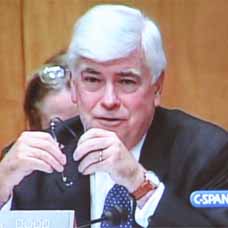 | Chris Dodd's Vision for the Peace Corps
Senator Chris Dodd (RPCV Dominican Republic) spoke at the ceremony for this year's Shriver Award and elaborated on issues he raised at Ron Tschetter's hearings. Dodd plans to introduce legislation that may include: setting aside a portion of Peace Corps' budget as seed money for demonstration projects and third goal activities (after adjusting the annual budget upward to accommodate the added expense), more volunteer input into Peace Corps operations, removing medical, healthcare and tax impediments that discourage older volunteers, providing more transparency in the medical screening and appeals process, a more comprehensive health safety net for recently-returned volunteers, and authorizing volunteers to accept, under certain circumstances, private donations to support their development projects. He plans to circulate draft legislation for review to members of the Peace Corps community and welcomes RPCV comments. |
 | He served with honor
One year ago, Staff Sgt. Robert J. Paul (RPCV Kenya) carried on an ongoing dialog on this website on the military and the peace corps and his role as a member of a Civil Affairs Team in Iraq and Afghanistan. We have just received a report that Sargeant Paul has been killed by a car bomb in Kabul. Words cannot express our feeling of loss for this tremendous injury to the entire RPCV community. Most of us didn't know him personally but we knew him from his words. Our thoughts go out to his family and friends. He was one of ours and he served with honor. |
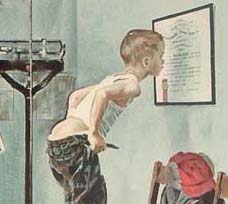 | Peace Corps' Screening and Medical Clearance
The purpose of Peace Corps' screening and medical clearance process is to ensure safe accommodation for applicants and minimize undue risk exposure for volunteers to allow PCVS to complete their service without compromising their entry health status. To further these goals, PCOL has obtained a copy of the Peace Corps Screening Guidelines Manual through the Freedom of Information Act (FOIA) and has posted it in the "Peace Corps Library." Applicants and Medical Professionals (especially those who have already served as volunteers) are urged to review the guidelines and leave their comments and suggestions. Then read the story of one RPCV's journey through medical screening and his suggestions for changes to the process. |
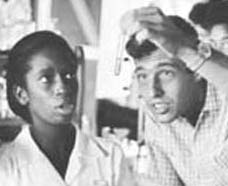 | The Peace Corps is "fashionable" again
The LA Times says that "the Peace Corps is booming again and "It's hard to know exactly what's behind the resurgence." PCOL Comment: Since the founding of the Peace Corps 45 years ago, Americans have answered Kennedy's call: "Ask not what your country can do for you--ask what you can do for your country. My fellow citizens of the world: ask not what America will do for you, but what together we can do for the freedom of man." Over 182,000 have served. Another 200,000 have applied and been unable to serve because of lack of Congressional funding. The Peace Corps has never gone out of fashion. It's Congress that hasn't been keeping pace. |
 | PCOL readership increases 100%
Monthly readership on "Peace Corps Online" has increased in the past twelve months to 350,000 visitors - over eleven thousand every day - a 100% increase since this time last year. Thanks again, RPCVs and Friends of the Peace Corps, for making PCOL your source of information for the Peace Corps community. And thanks for supporting the Peace Corps Library and History of the Peace Corps. Stay tuned, the best is yet to come. |
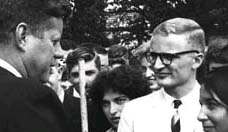 | History of the Peace Corps
PCOL is proud to announce that Phase One of the "History of the Peace Corps" is now available online. This installment includes over 5,000 pages of primary source documents from the archives of the Peace Corps including every issue of "Peace Corps News," "Peace Corps Times," "Peace Corps Volunteer," "Action Update," and every annual report of the Peace Corps to Congress since 1961. "Ask Not" is an ongoing project. Read how you can help. |
Read the stories and leave your comments.

Some postings on Peace Corps Online are provided to the individual members of this group without permission of the copyright owner for the non-profit purposes of criticism, comment, education, scholarship, and research under the "Fair Use" provisions of U.S. Government copyright laws and they may not be distributed further without permission of the copyright owner. Peace Corps Online does not vouch for the accuracy of the content of the postings, which is the sole responsibility of the copyright holder.
Story Source: Washington Post
This story has been posted in the following forums: : Headlines; National Service; National Service Academy; Congress
PCOL36737
90

